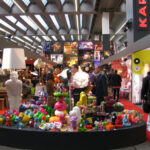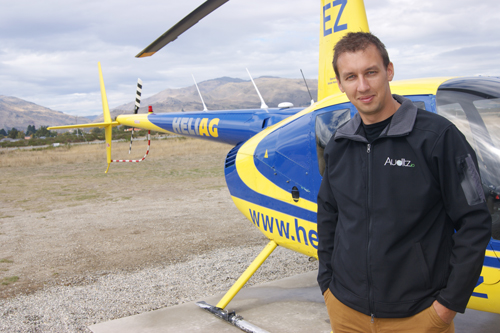Redcactus is a Kiwi brand strategy and packaging design agency that’s made a name for itself overseas. NZBusiness caught up with MD Chris Chong to discover the story behind his winning design firm.
For more than 28 years Chris Chong has been one of the leading, and most respected, figures in New Zealand’s design industry. Most of that time has been spent in Parnell, Auckland, heading up Redcactus – the agency he established in Wellington with Mike Pearce in 1994.
The son of fruit shop owners, and a fine arts graduate, this third-generation Chinese Kiwi quickly realised there was much more money to be made on “the dark side”
in commercial art, or graphic design as it was known back then.
After a brief stint overseas Chris found himself working for a Dutch design firm in Wellington, but soon realised that he had to be his own boss. While working in his parents shop he had picked up a lot about communication, money, how to negotiate with customers on price. “Fast forward 28 years and nothing’s really changed,” he tells NZBusiness.
“I always knew I’d go into business, it was just a matter of when,” he says.
Chris teamed up with ex-colleague Mike to launch Redcactus and be masters of their own destiny; to engage clients they wanted to work with; and have more fun.
After just six months they’d picked up Wellington Polytechnic, NZ Post and Unilever – the latter earning them the title of “the detergent designers” from their peers. “We were [Unilever’s] core design agency for many years.”
Then when Unilever closed its Petone operation and moved everything back to Australia, Redcactus became an Australasian agency by default.
The office grew to 20-plus staff and Redcactus was the capital’s third biggest design agency. But a major milestone was reached some five years after launching the business – one that would put Redcactus well and truly on the Auckland map.
Thanks to a referral, Chris was asked to pitch for the redesign of Tip Top’s Trumpet. Needless to say that pitch was successful, and it led on to other Tip Top products including ‘stick’ lines and two-litre tubs (now you know where the iconic blue tubs came from).
Auckland design firms were asking who this upstart agency from Wellington was. “In the industry in those days you were expected to play in your own backyard,” recalls Chris. “But one of the key things it taught us was that if you want to move forward you do have to look outside your backyard.”
More Auckland work followed – Eta Ripples was another scalp. The business was on a roll. Griffins was next – over two years every category of biscuit got the
Redcactus treatment.
In 2005 it was time to move away from the backyard and shift into a purpose-built office in Parnell. The Wellington office was subsequently closed nine years ago.
The buyout of Tip Top by Fonterra would broaden the horizons even further; Movenpick was launching into Japan, and there was plenty of work on the other side of the Tasman for Fonterra’s new dairy brands.
Today, in its 21st year of business, Redcactus can count KFC, Griffins, Eta, Nice & Natural, Charlies, Red Seal, RJ’s Licorice, Sanitarium, Precinct Properties and Rainbow Confectionary amongst its clients. Chris is incredibly proud of the success and longevity of his own brand, the respect, loyalty and trust of clients, the talent and team culture within the business.
While there’ve been countless successes there have also been a few account losses, which Chris insists must be celebrated as well. “You’ve got to learn from losses to move forward and get another win,” he explains.
“You also have to appreciate that New Zealand is a very small market; you only appreciate that fact when you work outside the country.
“It helps to see life outside your own backyard,” he says, adding that personally it has helped him to hone his communication skills in what is a pressure-driven industry.
Approaching assignments
Regardless of the size of budget, Redcactus has a simple philosophy when it comes to design – connect with the consumer. Understand the consumer – why do they need the product? Do as much analysis up front as you can.
“If you can capture that, then you can leapfrog the client’s brief and be ahead of the game. It’s all about understanding the needs of the target market. Why do they need this product? What’s the occasion for which they need it? What does the product stand for? What’s your point of difference?” says Chris. “And it doesn’t matter if the brand is an evolution or revolution.”
Once you have that information, you can merge it with the client’s brief, he says. “This then means the brief can be simpler and more single-minded.”
Redcactus analyses other brands and other categories to see how they targeted that need and occasion, and how Redcactus designs can be disruptive in that particular market sector.
Chris also says he’s incredibly loyal to his client’s brands – to the extent that his three young children are only allowed to buy KFC!
You may laugh, but consider that KFC is now a major client of Redcactus, and not just in New Zealand. There’s an interesting story behind how that relationship came about; how one of the world’s biggest QSR (Quick Service Restaurant) brands chose to work with a comparatively-tiny-but-extremely-nimble Kiwi design team; and how Redcactus ended up actually working in the world’s two biggest markets.
It began when Redcactus were asked to pitch new packaging creative for the US business. Needless to say Redcactus was sucessful and it has now been five years working on KFC’s US business including packaging, strategy, branding, product innovation, and the highly sort after BTL (below the line) business. The creative team love coming up with new ideas, they even developed a unique product idea called “Hot Shots” – a variation on popcorn chicken. It was a ‘blue sky’ concept pitched to KFC’s US CMO, who loved it so much they tasked Chris’s team with bringing it to reality in the US market.
Redcactus has also recently relaunched the entire KFC packaging system in China – which was a year long project. To achieve this he had to thoroughly research this market and its consumer. That process proved an eye-opener, as particularly in China, KFC has now become rooted in its own culture, and is not the western brand it once was. (There are 4,828 (YE2014) KFC outlets in China, with around 450 opening every year!)
His firm has also worked on the KFC brand in Australia for the past 11 years, relaunching KFC’s entire packaging system many times over the years – with the latest packaging design going best practice globally, and winning an international award.
For Redcactus, the opportunity to take on global work like this represented a paradigm shift in its thinking. Chris acknowledges they got lucky – but in essence they created their own luck.
Trends
So what are the big trends in packaging right now?
Chris says there’re two big ones – one relating to product, the other to packaging. “Packaging structure has to be unique,” he says. “Water bottles are a great example. It’s all about redefining form and function for the consumer – making it unique and ‘ownable’ to a particular brand.
“Again, it’s about need and occasion.”
The other trend relates to food (product) – and it’s being driven by TV’s “chef programmes”, Chris explains. High profile chefs create a new food or discover an offshore flavour and it quickly becomes mainstream here. “Mexican food is a great example. It won’t be long before there’re more Mexican foods and flavours packaged up on supermarket shelves.”
Chris has one big tip when it comes to branding and packaging design – engage a professional from day one – not a friend or your PA. “A professional will work to your budget.”
Going forward, he makes no secret of his global aspirations. “Working offshore definitely helps shape that creative paradigm.” But for now his main priorities, as they always have been, centre on servicing clients well, sustaining and growing the business, and maintaining a positive team culture.
And yes, these days his backyard is looking a whole lot bigger.



